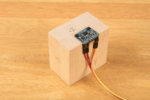Follow along with the video below to see how to install our site as a web app on your home screen.
Note: This feature may not be available in some browsers.
Please explain: why do you expect it to be always positive?the acceleration data should always be in positive if you did not move your wrist upside down.

Imagine strapping this on your wrist with the accelerometer on top, and if you do not move your hand then the accelerometer will always output positive data? As the accelerometer is not upside down therefore no negative data produced. With that, i can only acquire the "z_before" i will not be able to get the "z_now" then neither could i find the offset for this nor the final G value.
Hi,
you want me to read the datasheet for you and write the contents here in the forum?
Klaus
Datasheet specifies +/- 20°/s zero tolerance. Do you see larger gyro offsets?
Unless you do the initial zero adjustment in a roller coaster, there should be no actual problem, isn't it?
Hi wwfeldman,think of it as if you were calibrating a meter.
you connect it to the calibration machine, make the adjustments and use the meter for (some time period usually specified by contract or by local practice)
after the defined time period, bring the meter back to calibration machine and test again.
if its still calibrated, great
if not, calibrate it.
(some time period) is usually every 3 months, or every 6 months, or every year, depending.